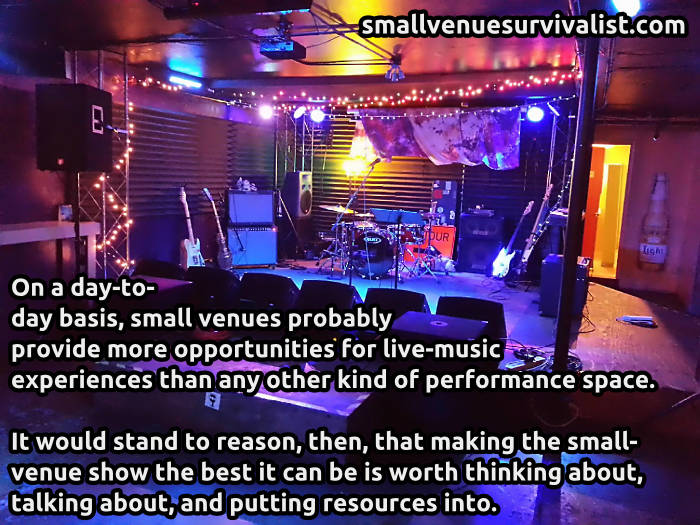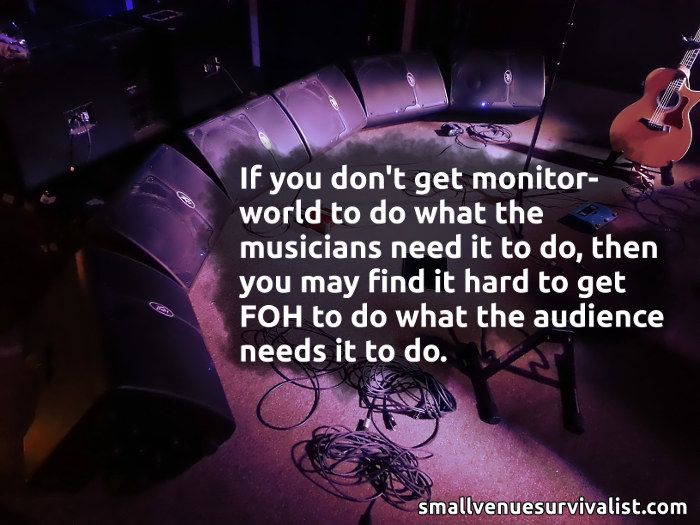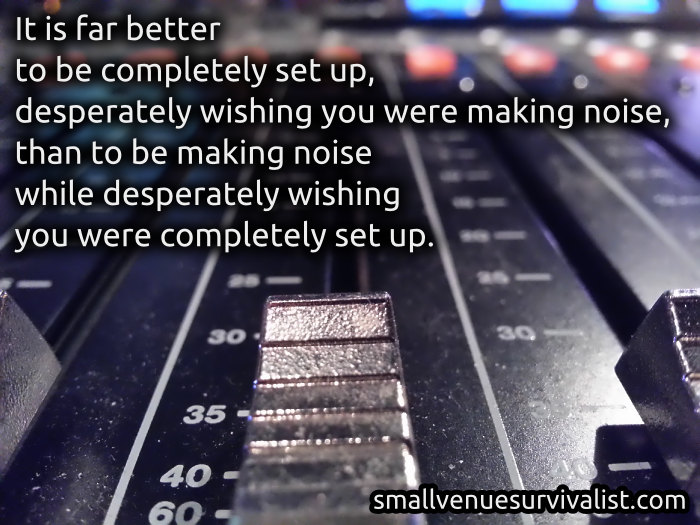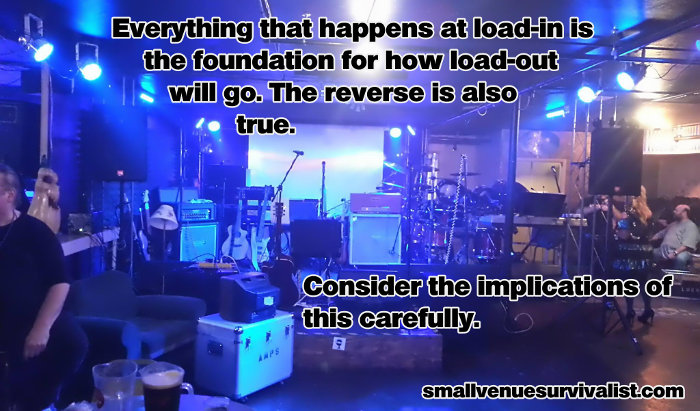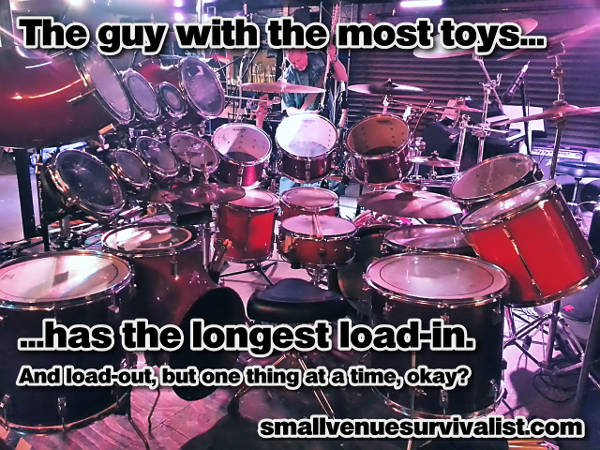Over the last several weeks, I’ve had the pretty-darn-neat job of mixing for livestreamed shows. AMR.fm is doing these live broadcasts on Monday nights, broadcasts that include Q&A with bands as well as live music.
It’s pretty nifty, both as an event and as a technical exercise. Putting your best foot forward on a live stream isn’t a trivial thing, but a big part of having fun is rising to a challenge, right?
Right?
Oh, come on. Don’t look at me like that. You know that challenges are where the serious enjoyment is. (Unless the challenge is insurmountable. Then it’s not so fun.)
Anyway.
The real bugaboo of doing an actual, honest-to-Pete live gig that’s also being streamed is that you have at least two different audiences, each with different priorities. To keep them all happy, you need to be able to address each separate need independently (or quasi-independently, at least). I use the word “need” because of one particular reality:
In a small-venue, the needs of the show in the room are often contrary to the needs of the show on the stream.
One way that is manifests in practical terms is that…
You Probably Don’t Want A Board Feed
“Board Feeds” can be wondrous things. In a large venue, with reasonable stage-volume, there’s a real chance that everything is in the PA, and at “full range.” That is to say, the mix includes all the instruments (even the loud ones), and the tonal shaping applied to each input is only minimally influenced by the acoustic contribution from the stage. The PA is being used to get the ENTIRE band out to the audience, and not just to fill in the spaces where a particular input isn’t at the right volume.
In the above scenario, taking a split from the main mix (before loudspeaker processing) could be a great and easy option for getting audio to stream out.
In a small venue, though, things can be rather more tricky.
I’ve written about this before. In a small room, putting everything in the PA is often unnecessary…and also a bad idea. It’s very possible to chase everybody out with that kind of volume. Rather, it’s desirable to only use the PA for what’s absolutely necessary, and ignore everything else. The “natural” acoustical contribution from the band, plus a selective contribution from the PA come together into a total acoustic solution that works for the folks in the room.
The key word there is “acoustic.”
A small-venue board feed to a live stream is often the wrong idea, because that feed is likely to sound VERY different than what’s actually in the room. The vocals might be aggressively high-passed. The guitar amps might not be present at all. The drums might sound very odd, and be very low in the mix.
And it’s all because the content of that feed is meant to combine with acoustic events to form a pleasant whole. Unfortunately, in this situation, a board-feed plus nothing is lacking those acoustical events, and so the stream sounds terrible.
The Right Mix For The Right Context
Obviously, you don’t want the stream to sound bad, or even just “off.” So – what can you do? There are two major options:
1) Capture the total acoustical event in the room, and stream that.
2) Have a way to create an independent mix for the stream that includes everything, and in a natural tonality.
The first option is easy, and often inexpensive, but it rarely sounds all that great. Micing a room, even in stereo, can be pretty “hit or miss.” Sure, a nice stereo pair in a symphony hall is likely to sound pretty good, but most folks aren’t playing symphonies in a concert hall to a quiet crowd. As likely as not, you’re streaming some kind of popular music style that’s taking place in a club, and the crowd is NOT being quiet.
Now, even with all that, there’s nothing wrong with taking the first option if it’s all you’ve got. I’ve personally enjoyed my fair share of concert videos that are nothing more complex than “micing the room.” Still, why not reach higher if you can?
Trying for something better requires some kind of “broadcast split.” There are different ways to make it happen, but the most generally feasible way is likely the route that I’ve chosen: Connect each input to two separate mix rigs. A simple splitter snake and a separate “stream mix” console are pretty much what you need to get started.
The great thing about using a separate console for the broadcast is that you have the freedom to engage in all kinds of weirdness on either console (live or stream), without directly affecting the other mix. Need a “thin” vocal in the room, but a rich and full tone for the stream? No problem! Do the guitar amps need no help from the PA, but do need to be strongly present for the broadcast audience? No sweat! Having separate consoles means that the “in-studio” audience and the stream listeners can both be catered to, without having to completely sacrifice one group on the other’s altar.
Having a totally separate mix for the broadcast is not without its own challenges, though. It would be irresponsible for me to forget to point out that mixing for two, totally separate audiences can be a real workout. If you’re new to audio, you might want to have a different person handle one mix or the other. (I’m not new to being a sound human, but I still have to cope by giving neither the live nor the broadcast mixes my full attention. I take every shortcut I can on “broadcast day,” and I let plenty of things just roll along without correction for much longer than I usually would.) Even with separate mix rigs, the broadcast mix is still partially (though indirectly) affected by the acoustical events in the room – like “ringy” monitors on deck. That being so, any “live” problem you have is likely to be VERY audible to the broadcast audience. If you’re the only one around to manage it all, that’s fine…but be ready.
I should also mention that having some way to do “broadcast levelling” on the stream feed is a good idea. Especially in my case, where we transition from Q&A to music, the dynamic range difference involved can be pretty startling. To the folks in the room, the dynamic swing is expected to some degree. To the stream listeners, though, having to lunge for the volume control isn’t too pleasant. One way to create a broadcast leveller is to insert a brickwall (infinity:1, zero attack) limiter with a long (say, five seconds) release time across the entire broadcast mix. You then set the threshold and output gain so as to minimize the difference between the loud and soft portions of the program. Using automatic levelling does sound a bit odd versus doing it manually, but it can free up your attention for other things at times.
Then again, automatic levelling does require you to do more to manage your broadcast-mix channel mutes, because a side effect of making everything “the same amount of loud at all times” means that your noise floor gets CRANKED.
…but hey, if this gig wasn’t interesting, we wouldn’t want it, right?

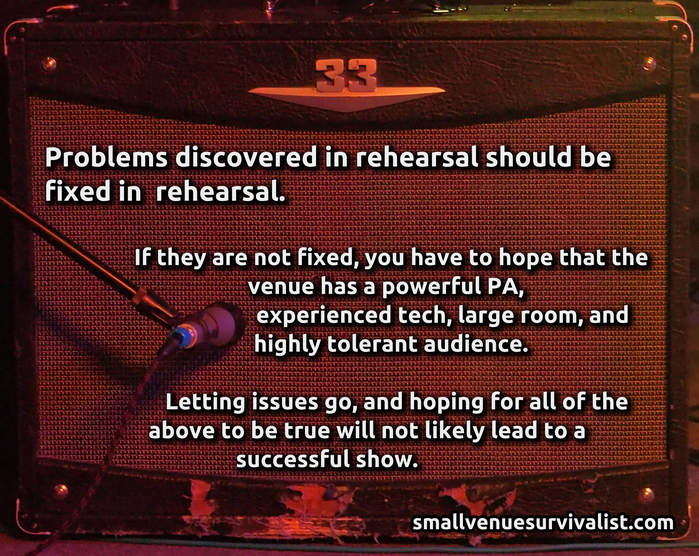 Want to use this image for something else? Great! Click it for the link to a high-res or resolution-independent version.
Want to use this image for something else? Great! Click it for the link to a high-res or resolution-independent version.